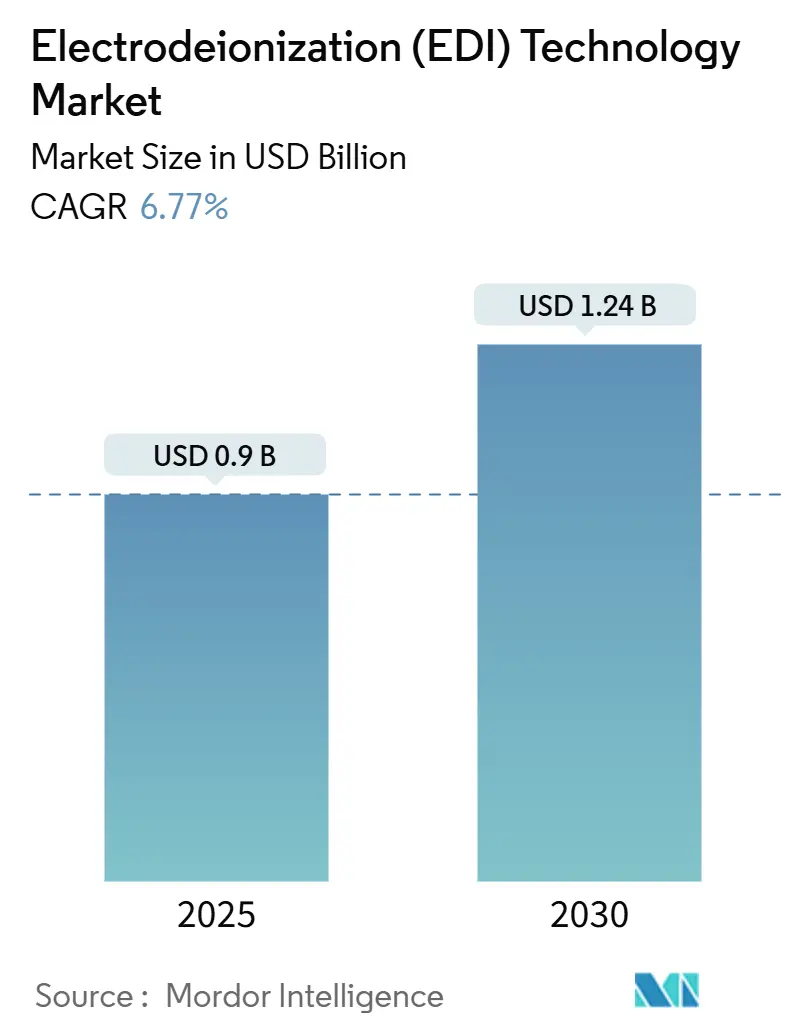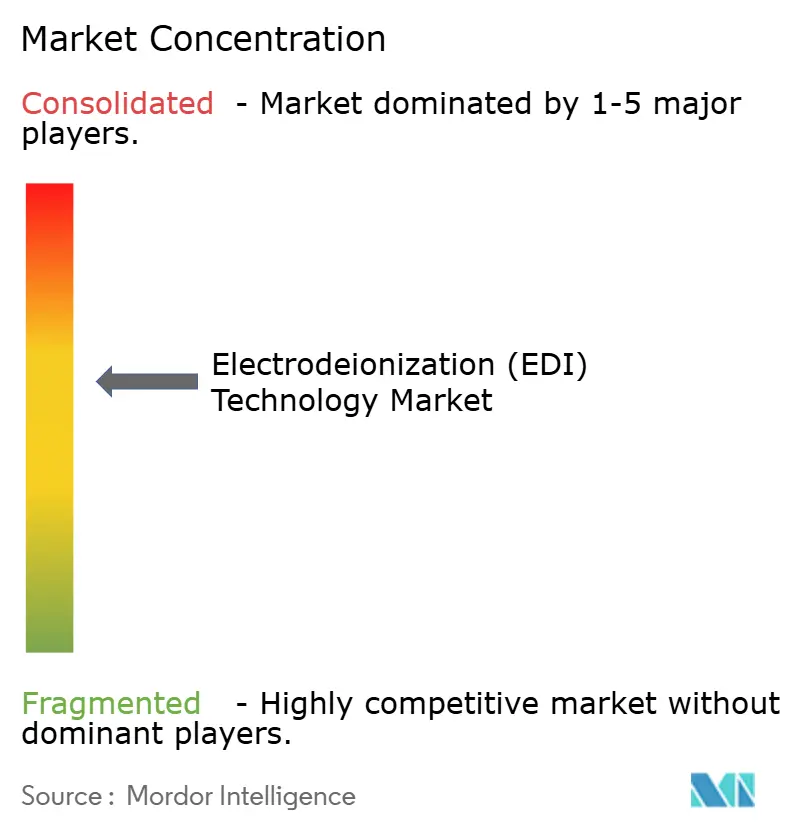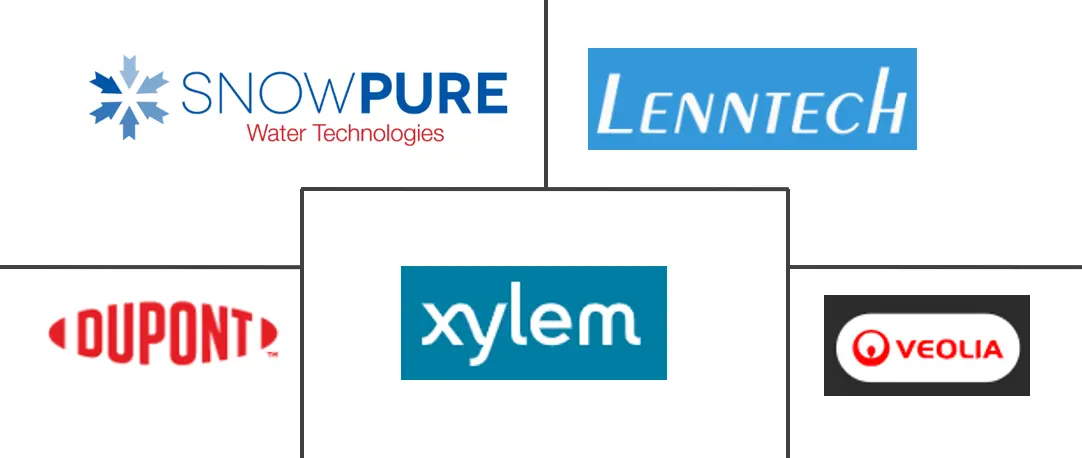Electrodeionization (EDI) Technology Market Size and Share

Electrodeionization (EDI) Technology Market Analysis by Mordor Intelligence
The Electrodeionization (EDI)Technology Market size is estimated at USD 0.9 billion in 2025, and is expected to reach USD 1.24 billion by 2030, at a CAGR of 6.77% during the forecast period (2025-2030). Demand acceleration is rooted in the shift toward chemical-free ultrapure water production for high-pressure boilers, semiconductor fabrication, and biopharmaceutical processes. Continuous regeneration capability eliminates hazardous regenerants and downtime, improving the total cost of ownership in comparison with mixed-bed ion exchange. Rapid green-hydrogen build-outs, heightened PFAS discharge limits, and the rising value placed on 24/7 bioprocess uptime add further momentum. Meanwhile, competitive differentiation centers on spiral-wound module design, hybrid membrane-resin innovations, and turnkey skid packages that reduce skilled-labor needs during commissioning.
Key Report Takeaways
- By product type, plate-and-frame modules captured 61.91% of the electrodeionization technology market size in 2024, while spiral-wound modules are set to expand at a 6.87% CAGR to 2030.
- By application, power generation led with 40.41% of the electrodeionization technology market share in 2024; pharmaceuticals are projected to record the fastest 7.18% CAGR through 2030.
- By geography, Asia-Pacific commanded 41.64% revenue in 2024 and is forecast to post the highest 8.03% CAGR during 2025-2030.
Global Electrodeionization (EDI) Technology Market Trends and Insights
Driver Impact Analysis
| Drivers | (~) % Impact on CAGR Forecast | Geographic Relevance | Impact Timeline |
|---|---|---|---|
| Green-hydrogen electrolyzer demand for ultrapure water | +1.8% | Global, higher in Europe and APAC | Medium term (2-4 years) |
| Continuous bioprocessing adoption in cell- and gene-therapy plants | +1.2% | North America and EU, emerging APAC | Long term (≥ 4 years) |
| Modular EDI skids for edge-cloud micro-data centers | +0.9% | Global, early uptake in North America | Short term (≤ 2 years) |
| Hybrid membrane-resin cost-down innovations | +0.7% | Global | Medium term (2-4 years) |
| PFAS discharge limits favoring chemical-free polishing | +1.1% | North America and EU, global rollout | Long term (≥ 4 years) |
| Source: Mordor Intelligence | |||
Green-Hydrogen Electrolyzer Demand for Ultrapure Water
Producing 1 kg of green hydrogen requires 9–10 liters of ultrapure water, and electrolyzer OEMs now specify electrodeionization polishing to meet sub-0.1 µS/cm resistivity targets essential for membrane electrode longevity. Large projects such as the Helios complex integrate desalination with EDI to protect billion-dollar electrolyzer assets. Adoption favors compact spiral-wound stacks that fit modular hydrogen skids and achieve more than or equal to 90% recovery while cutting footprint.
Continuous Bioprocessing Adoption in Cell- and Gene-Therapy Plants
Moving from batch to continuous manufacturing requires uninterrupted high-purity utility streams. EDI’s electrical self-regeneration eliminates resin changeouts that would otherwise halt 24/7 bioreactors, ensuring compliance with USP and EP water specifications. The technology’s low weak-base leakage preserves delicate cell-culture media and supports single-use facility rollouts.
Modular EDI Skids for Edge-Cloud Micro-Data Centers
Distributed AI workloads push hyperscalers to deploy micro-data centers in remote settings. Factory-assembled, plug-and-play EDI skids provide chemical-free make-up water for closed-loop evaporative cooling, trimming maintenance visits, and hazardous-material handling. Remote SCADA connectivity further mitigates the shortage of locally trained technicians.
PFAS Discharge Limits Favoring Chemical-Free Polishing
The U.S. EPA’s 2024 National Primary Drinking Water Regulation imposes stringent PFAS maximum contaminant levels, channeling USD 11.7 billion of infrastructure funding toward advanced, non-chemical polishing technologies[1]U.S. EPA, “Best Available Technologies for PFAS,” epa.gov. EDI sidesteps secondary waste streams generated by ion-exchange regenerants and granular activated carbon, aligning with regulators’ source-reduction philosophy.
Restraint Impact Analysis
| Restraints | (~) % Impact on CAGR Forecast | Geographic Relevance | Impact Timeline |
|---|---|---|---|
| Rise of membrane capacitive deionization for less than 1 µS/cm specs | -1.4% | Global brackish-water segments | Medium term (2-4 years) |
| Supply-chain risk for fluoropolymer ion-exchange membrane precursors | -0.8% | Global, acute in APAC | Short term (≤ 2 years) |
| Skilled-labor shortage for high-pressure EDI commissioning | -0.6% | North America and Europe | Long term (≥ 4 years) |
| Source: Mordor Intelligence | |||
Rise of Membrane Capacitive Deionization for Less than 1 µs/Cm Specs
MCDI delivers 40–70% lower energy demand and up to 95% recovery compared with RO–EDI hybrids, positioning it as a low-cost alternative for mildly saline feeds. Emerging carbon-nanotube electrodes further shrink LCC, enticing sustainability-focused industries.
Skilled-Labor Shortage for High-Pressure EDI Commissioning
An aging water-treatment workforce and limited vocational curricula add installation risk, as incorrect polarity alignment or pressure mismatch can irreversibly damage stacks. The U.S. Department of Labor is injecting USD 65 million into water-industry apprenticeships, yet EDI-specific know-how remains scarce[2]U.S. Department of Labor, “Community College Training Grants,” waterworld.com.
Segment Analysis
By Product Type: Plate-and-Frame Dominance Meets Spiral-Wound Momentum
Plate-and-frame designs retained 61.91% of the electrodeionization technology market share in 2024 owing to heritage installations and straightforward gasket maintenance. Utilities value their linear flow paths and ease of module replacement. However, spiral-wound stacks are climbing at a brisk 6.87% CAGR as space-constrained facilities, notably semiconductor fabs and mobile hydrogen skids, prioritize a smaller footprint.
Energy consumption per cubic meter narrows between the formats as vendors optimize channel hydraulics and current density. Hybrid innovations, such as membrane-free electrodeionization that merges features of both geometries, are poised to reset cost curves and broaden the electrodeionization ((EDI) technology market size across mid-tier industrial users.

By Application: Power Generation Reinforces Leadership
Power plants accounted for 40.41% of electrodeionization technology market revenue in 2024, underscoring the need for 0.3–0.4 µS/cm boiler feedwater to avoid turbine scaling. This segment consumed the largest slice of the electrodeionization technology market size because EDI replaces acid and caustic regenerants, cuts outage time, and extends tube life. OEMs now bundle EDI behind RO pretreatment in combined-cycle gas plants as well as super-critical coal installations.
The pharmaceuticals sector, although smaller, registers the quickest 7.18% CAGR through 2030 as cell-therapy suites proliferate. Water-for-injection lines trust EDI’s continuous operation to eliminate batch resin swap-outs that jeopardize aseptic runs. Food and beverage producers integrate EDI into cleaning-in-place circuits, benefiting from chemical-free sanitization that aligns with HACCP compliance. Electronics fabs rely on the technology for removing trace silica and boron that degrade wafer yields. Nascent opportunities in green-hydrogen hubs and edge-data-center cooling diversify the demand base, supporting a healthy, multi-vertical spread for the electrodeionization (EDI) technology market.

Note: Segment shares of all individual segments available upon report purchase
Geography Analysis
Asia-Pacific led the electrodeionization (EDI) technology market with 41.64% revenue in 2024 and is projected to grow at 8.03% CAGR through 2030. Semiconductor manufacturing clusters in China, Taiwan, and South Korea install new fab lines that require ultrapure water resistivity at 18.2 MΩ-cm, standards readily met by multistage RO-EDI trains. Parallel coal-to-chemicals and biomass power developments also reinforce regional uptake. Government targets for gigawatt-scale green-hydrogen electrolyzers in Australia, Japan, and India magnify long-term visibility for EDI modules in process-water polishing skids.
North America presents a mature yet opportunity-rich landscape. The U.S. EPA’s PFAS maximum contaminant levels catalyze the replacement of mixed-bed polishers with EDI, which avoids secondary brine waste. Biopharma hubs in Massachusetts and California invest in continuous twin-train EDI arrangements to secure validation redundancy. Municipalities exploring advanced treatment for reuse also evaluate electrically regenerated technologies to limit chemical exposure, especially in drought-prone states.
Europe’s regulatory thrust toward circular economy and carbon-neutral industry sustains steady adoption. Renewable-energy incentives nurture green-hydrogen pilot plants in Germany, the Netherlands, and Spain, each specifying EDI polishing for electrolyzer feed streams. Scandinavian combined heat-and-power sites report strong field performance of Dow EDI modules in bioenergy condensate recovery loops, underscoring reliability in harsh Nordic climates. Latin America and the Middle-East and Africa trail in revenue but post rising growth as pulp-and-paper mills, desalination projects, and petrochemical complexes elevate water-quality standards.

Competitive Landscape
The electrodeionization (EDI) technology market is moderately fragmented. DuPont, Veolia, and GE command significant installed bases. Strategic focus has shifted toward spiral-wound architecture, AI-based process control, and digitally enabled service packages. Emerging players address niche deployments, such as edge-cloud data centers, by selling pre-wired, plug-and-play EDI skids with remote diagnostics, minimizing the skilled-labor barrier. Consolidation persists: headline 2024–2025 deals included Xylem’s analytics-focused buyouts and Pentair’s bolt-on of membrane start-ups. Competitive intensity is expected to sharpen as MCDI vendors court overlapping customer segments.
Electrodeionization (EDI) Technology Industry Leaders
-
DuPont
-
Lenntech B.V.
-
SnowPure LLC
-
Veolia
-
Xylem
- *Disclaimer: Major Players sorted in no particular order

Recent Industry Developments
- January 2025: Pure Water Group shipped three CEDI systems based on Ionpure LXM45X-4 modules, each producing 6,500 L/h of less than 0.1 µS/cm water for industrial processes.
- April 2024: Aquatech launched commercial production at its Pune, India membrane plant, scaling output of FEDI GIGA fractional electrodeionization and ultrafiltration cartridges.
Global Electrodeionization (EDI) Technology Market Report Scope
The Electrodeionization (EDI) Technology Market report includes:
| Plate-and-frame Module |
| Spiral Wound Module |
| Power Generation (Power Plants) |
| Electronics and Semiconductors |
| Food and Beverage |
| Pharmaceuticals |
| Other Applications |
| Asia-Pacific | China |
| India | |
| Japan | |
| South Korea | |
| Rest of Asia-Pacific | |
| North America | United States |
| Canada | |
| Mexico | |
| Europe | Germany |
| United Kingdom | |
| France | |
| Italy | |
| Rest of Europe | |
| South America | Brazil |
| Argentina | |
| Rest of South America | |
| Middle-East and Africa | Saudi Arabia |
| South Africa | |
| Rest of Middle-East and Africa |
| By Product Type | Plate-and-frame Module | |
| Spiral Wound Module | ||
| By Application | Power Generation (Power Plants) | |
| Electronics and Semiconductors | ||
| Food and Beverage | ||
| Pharmaceuticals | ||
| Other Applications | ||
| By Geography | Asia-Pacific | China |
| India | ||
| Japan | ||
| South Korea | ||
| Rest of Asia-Pacific | ||
| North America | United States | |
| Canada | ||
| Mexico | ||
| Europe | Germany | |
| United Kingdom | ||
| France | ||
| Italy | ||
| Rest of Europe | ||
| South America | Brazil | |
| Argentina | ||
| Rest of South America | ||
| Middle-East and Africa | Saudi Arabia | |
| South Africa | ||
| Rest of Middle-East and Africa | ||
Key Questions Answered in the Report
What is the projected value of the electrodeionization technology market in 2030?
The market is expected to reach USD 1.24 billion by 2030 based on a 6.77% CAGR.
Which application currently dominates spending on electrodeionization systems?
Power generation leads, accounting for 40.41% revenue in 2024 due to strict boiler-feedwater purity requirements.
Why are spiral-wound EDI modules gaining popularity?
They deliver smaller footprint and improved membrane utilization, expanding uptake in space-constrained fabs and modular hydrogen skids.
How do PFAS regulations influence adoption?
New U.S. limits encourage chemical-free polishing methods, favoring EDI over mixed-bed IX that produce regenerate waste.
What geographic region is growing fastest through 2030?
Asia-Pacific is set to expand at 8.03% CAGR, driven by semiconductor fab investments and green-hydrogen projects.
Page last updated on:



